Let’s play some word association. We say, “Italy seaside,” and you say, “Amalfi Coast towns,” yes? Along with Cinque Terre, Forte Dei Marmi, Sicily’s Ionian Coast, and the Costa Viola, the Amalfi Coast is one of the most sought-after seaside destinations for Italian travelers.
And with good reason: this postcard-perfect stretch of the Southern Italian coast is a mix of dolce vita glitz and historic fishing villages punctuated by sea breezes and pastel towns.

From Ravello to Positano, you’ll want to explore this beautiful stretch of coastline. However, like many destinations, it can become crowded, pricey, and touristy — so enter this insider’s guide. After years of providing travel planning services to clients visiting Amalfi Coast towns, we are sharing intel with you.
Why You Should Trust Us
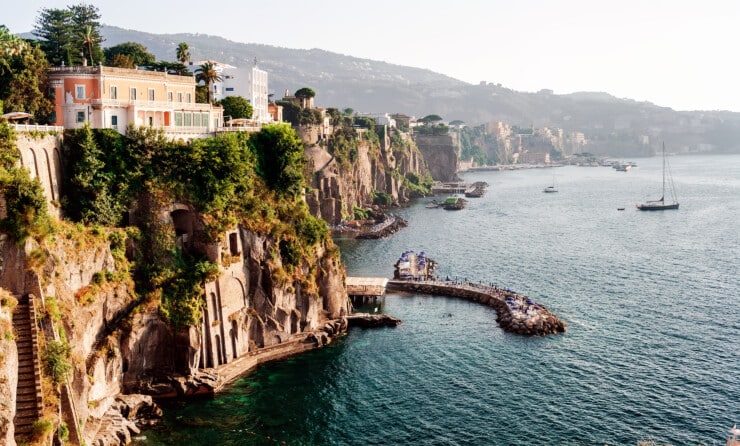
The 13 Main Amalfi Coast Towns
If you’re wondering what the Amalfi Coast is, we’ve got you. The Amalfi Coast is in the Southern Italian region of Campania (where the main city is Naples). It begins south of Sorrento, at Punta Campanella, and extends to Salerno.
Most travelers visit thirteen Amalfi Coast towns and villages—check out this map to get oriented. From north to south, they are Nerano, Positano, Nocelle, Praiano, Furore, Conca dei Marini, Amalfi, Atrani, Ravello, Maiori, Minori, Cetara, and Vietri sul Mare.
Some of our clients stay in Sorrento to explore the greater area for the first time. Others set up in Amalfi or Positano if they want to be on the Amalfi Coast properly.
We have a whole article on how to get to the Amalfi Coast from Naples, but here is some info. These towns have regular hydrofoil service in the summer, making them ideal launching pads for exploring (i.e., day trips to Pompeii, Naples, or the islands of Ischia, Procida, and Capri). Despite their charm, they also have the biggest crowds.
Sorrento: The Gateway To The Amalfi Coast
Between the mountains and the Mediterranean, Sorrento is not part of the Amalfi Coast, but rather located just north of it. It’s well-located for regional sightseeing and is worth exploring in its own right. There is a historic old quarter with cobblestone streets, a lively main shopping street (though some sell tourist trinkets), and a bustling piazza.
The beachfront promenade leads to Marina Grande, which served as the backdrop for the Sophia Loren movie “Pane, Amore, e…” Sorrento is the most affordable of the area’s larger towns, offering many nice 3-star and 4-star hotel options. In the height of summer, you can quickly ferry from there to Naples, Capri, Positano, or Amalfi.
Best suited for: First-time travelers to Europe, those who don’t speak Italian, and those who are comfortable with crowds. A home base allows you to see the wider region, especially if you only have a few days.
Nerano: The Tucked-Away Fishing Village
The Punta Campanella Natural Marine Reserve marks the start of the Amalfi Coast, and the first town is the fishing village of Nerano. The village’s small rocky beach gives way to clear waters frequented by scuba divers.
And it has a history: according to Greek mythology, this is where the sirens sang to tempt Ulysses. Nerano is also home to the culinary gem spaghetti alla Nerano, which is made with fried zucchini and local provolone cheese.
Best For: Those who want to hike in nature, who don’t mind being removed from the center of the action, who are okay with a small village, or who have been before and want a quieter experience.
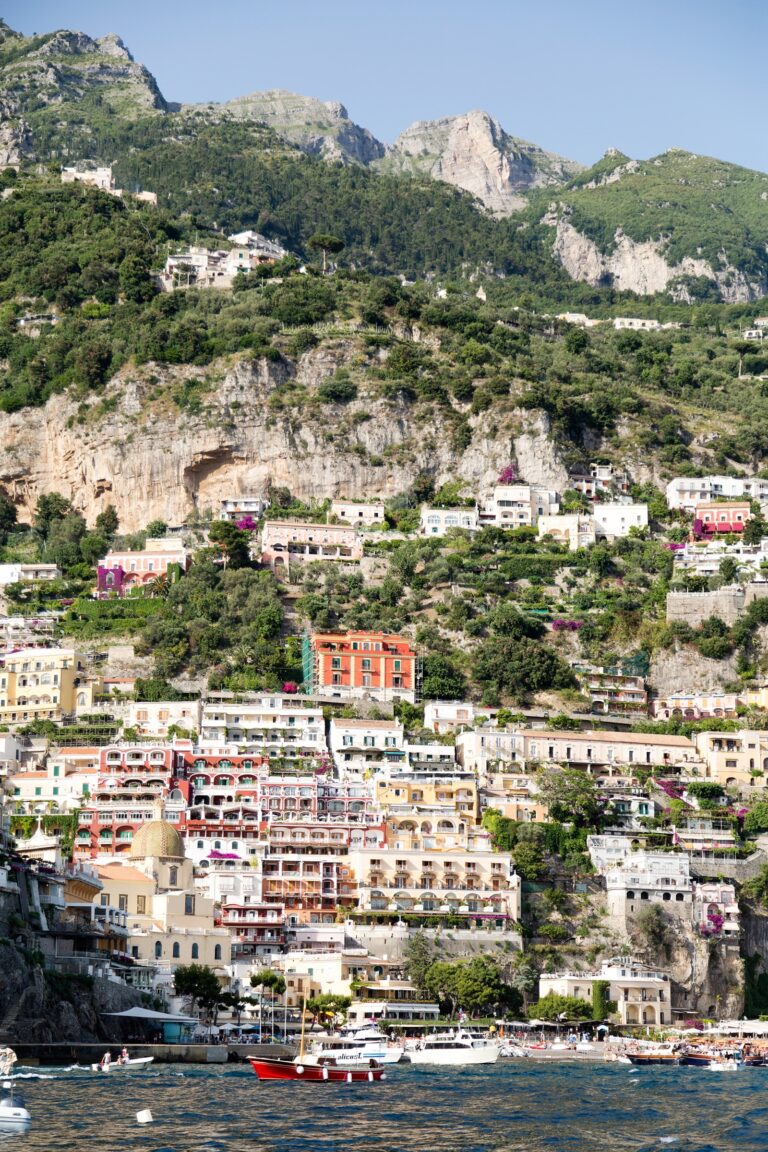
Positano: The Jet Set Favorite
South of Nerano is the picturesque town of Positano, which many consider the crown jewel of the Amalfi Coast. It’s where everyone from starlets to billionaires stays, and despite the crowds, it remains utterly stunning.
One doesn’t visit Positano for its sights or history because there isn’t much to see. Instead, you go for the views, the boutique shopping, the nightlife, and the Italian seaside vibes. As such, you’ll want to visit during the season, as that is the best time to go to Positano, Italy, which typically runs from around Easter (when you can get excellent Italian Easter food) through the start of fall.
With swanky bars, sweeping views, and beachside nightclubs, it has the best nightlife scene of all the Amalfi Coast towns. Most hotels are gorgeous but pricey (see the famed Il San Pietro), but there are a few relatively more affordable options.
FYI, most hotels are located in the town proper, so few have pools, and almost none offer direct beach access (if they do, it’s a car ride away, as you have to leave town). The city juts up the hillside from the water, so you must take steep stairs to get anywhere. From Positano, you can take a ferry to Naples, Capri, Sorrento, or Amalfi during the high season.
Best For: Living your best luxe life, for shopping, for nightlife, for being centrally located on the Amalfi Coast, for having access to a sandy beach (many other towns have rocky beaches)
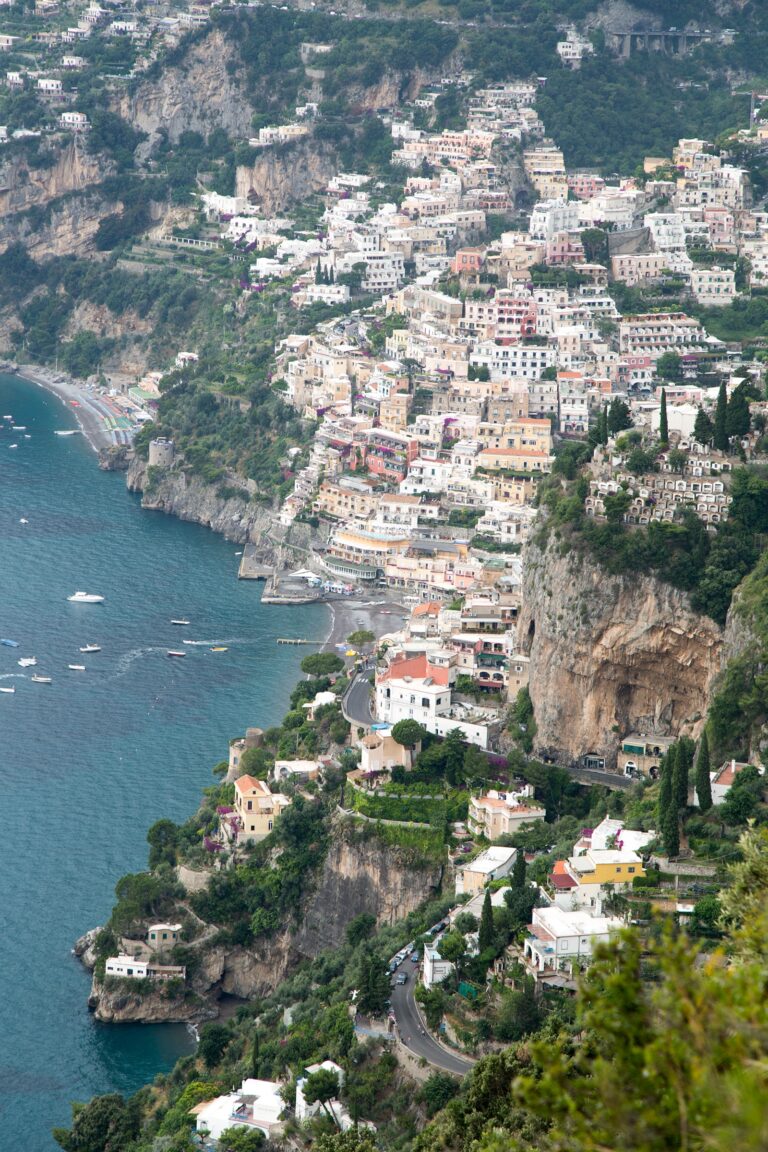
Nocelle: The Hidden Mountain Village
This tiny, isolated village is situated high above Montepertuso, at an elevation of almost 500 meters above sea level. As such, it boasts some of the most sweeping views of any town on the Amalfi Coast. There isn’t much of a village here, and it’s mostly locals, so it’s not where most tourists stay. However, many end up here since it is the endpoint of the Sentiero degli Dei, or Path of the Gods, hiking trail.
Praiano: The Artsy Spot
A few bends southeast of Positano lies the relaxed town of Praiano, which boasts some quaint, family-owned accommodations. This ancient fishing village doubles as a laid-back summer resort and is gaining recognition due to its burgeoning creative scene.
There isn’t a village center in Praiano, but it has a church with a colorful dome and a rocky beach, La Gavitella, at the bottom of 350-plus steps. Go here to be in the heart of the Amalfi Coast without crowds. But also know you won’t have much of a “town” to walk in.
The advantage of being in Praiano is that you’re away from the main towns’ crowds and centrally located on the coast. Hence, it’s as quick to explore Positano as it is to towns like Ravello and Amalfi to the south (about a 20-minute drive to any of those spots). There tends to be more space at the hotels than in Positano (some have private beaches), and you often have a lovely view back in Positano.
The disadvantage is that there is no proper town with a central square, and you don’t have the significant ferry services of Positano. It’s best to have a private boat service or private driver (many hotels have transport services) to reach Praiano.
Best For: Those wanting to stay near the action but not in it, those okay with using private drivers or boat service to get around, or those who want to stay in a family-owned hotel or a rental house
Conca dei Marini: The Etruscan Settlement
Just around the bend from the Capo di Conca headland is the quaint fishing village of Conca dei Marini. Sandwiched between the town of Furore and Amalfi, Conca dei Marini is believed to have been founded by the Etruscans.
This is one of the smallest villages on the Amalfi Coast, so it’s harder to get around, but it brings charm with its colorful houses, a few restaurants, and a charming chapel that surrounds a small beach.
Best For: Outdoor lovers who want to hike or dive the nearby sea caves, for a romantic escape, for small-town vibes, for escaping the bustle but having it nearby, or those okay with using private drivers or boat service to get around
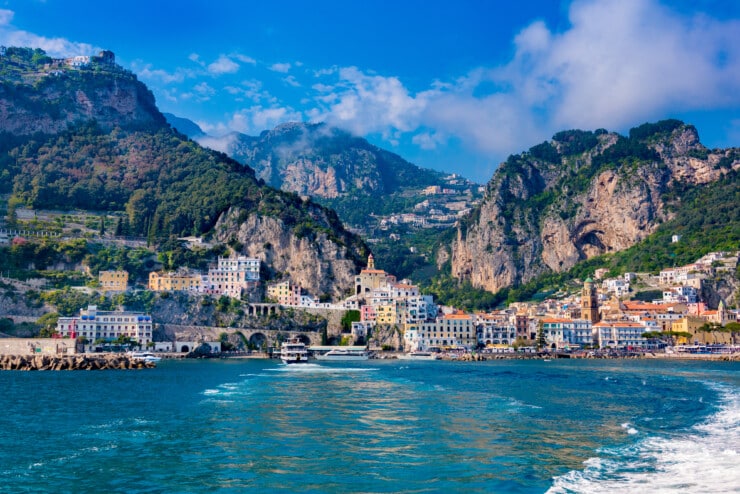
Amalfi Town: The Most Central Town
The coast’s namesake town, Amalfi, is one of the biggest Amalfi Coast towns. Its main piazza (and stunning duomo or cathedral) is at sea level, which rises, meaning there is more to walk at sea level than elsewhere on the coast. Like Sorrento and Positano, you’ll see cruise ship tours and other day trippers in the town center, but it will get quieter when sundown comes.
There are great restaurants, a beautiful historic church, and shopping (though some are touristy). You can ferry to and from Naples, Capri, Positano, or Sorrento. The nearby towns of Furore, Ravello, and Atrani are all worth a visit for dinner or a drink.
The town’s population barely tops 5,000 full-time residents, but it was once an imposing maritime power with a population of more than 70,000. Unfortunately, there aren’t many historical buildings because an earthquake in 1343 caused most of the old city to fall into the sea. After you’ve enjoyed the sights of the town itself, make sure to venture further inland, where hidden gems like the Valle dei Mulini hike await!
Best For: Being in the midst of the Amalfi coast, quickly heading on day trips, easily getting around, and enjoying the beach; you’re okay with a bustling daytime scene.
Atrani: Amalfi’s Little Sister
The sun-soaked village of Atrani is just around the bend from Amalfi and offers a lovely, slow-paced contrast to the nearby town. As one of the smallest towns on the Amalfi Coast, we don’t necessarily recommend staying here, but instead suggest doing a day trip or enjoying dinner, which allows you to appreciate its lovely beach and charming cliffside setting.
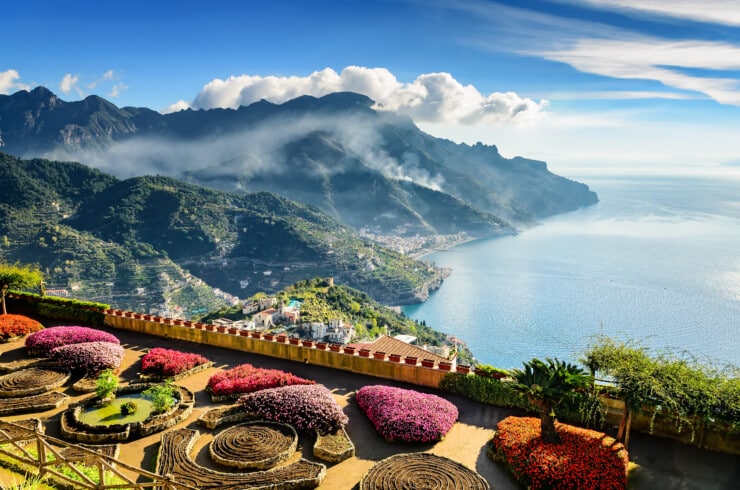
Ravello: The Hilltop Escape
Set 1,000 feet above sea level, Ravello is a total gem. While many consider Amalfi and Positano the most beautiful Amalfi Coast towns, the small town of Ravello is also a contender. It’s renowned for its cliffside gardens and historic sites, such as the stunning Villa Rufolo and Villa Cimbrone. Standing on a rocky promontory that once housed the ruins of a Roman villa, the historic Villa Cimbrone boasts one of the most spectacular views on the entire Amalfi Coast.
Founded in the 5th century, this town began as a haven from barbarian invaders. It’s long been a destination for artists: Richard Wagner claimed the beauty of this town cured his writer’s block, and DH Lawrence worked on Lady Chatterley’s Lover there.
There are incredible hotels, such as the stunning Belmond Caruso, but we think it’s worth taking a day trip. Otherwise, you’ll be far from the water and a bit removed from the rest of the region. From July to August, the renowned Ravello Festival takes place, featuring live orchestral concerts, ballet performances, and film screenings.
Best For: Escaping the crowds, all while still being able to reach the seaside Amalfi Coast scene; enjoying a stunning view; not needing a beachfront spot; having peaceful nights; or those who are okay with using private drivers or boat services to get around.
Minori: The Good Value Town
Just southeast of Amalfi (or a steep hike down from Ravello) is the working-class town of Minori. This small seaside village is less refined than the Amalfi Coast towns to the north, but it’s decidedly more real, with noisy traffic jams and a bustling, tiny beachfront. Travelers like staying here for a less glitzy seaside spot that almost always has a pleasant sea breeze blowing.
The town is known as the “City of Taste,” thanks to its terraced lemon groves, grapevines, and high-quality restaurants. However, it’s best known for being the home of the beloved scialatielli (thick ribbons of fresh pasta), which is featured on many local restaurant menus. These days, it’s also famous for being home to the Pasticceria Sal de Riso, where famed pastry chef Salvatore de Riso creates treats like the Torta Ricotta e Pere.
Best For: A more budget experience, a more family-friendly experience, a less glitzy option
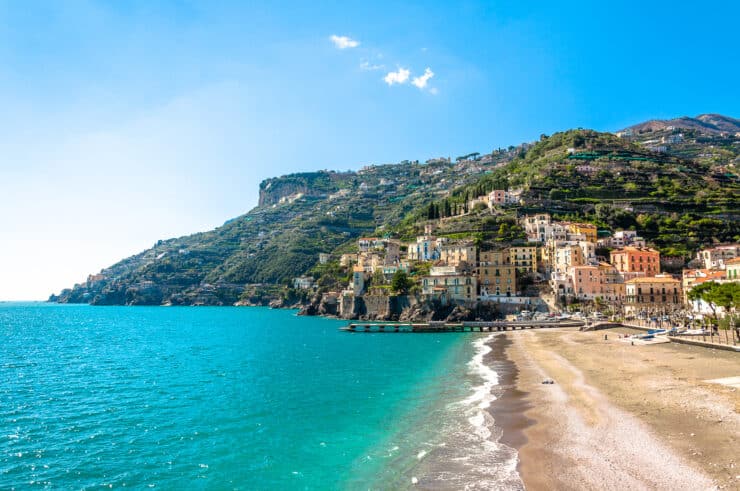
Maiori: The Town With A Big Beach
South of Minori lies the town of Maiori, which has been a tourist destination since Roman times. Although the city boasts historic monuments such as the Collegiate Church of Santa Maria a Mare (13th century) and the Church of San Francesco (completed in 1590), it’s best known for having the longest and largest beach on the Amalfi Coast.
Like Minori, this is a town where local Italians are more frequent than international tourists and has less tourism infrastructure than the towns to the north.
Best For: A more budget experience, a more family-friendly experience; you want a larger beach; you want to avoid the crowds of the main towns.
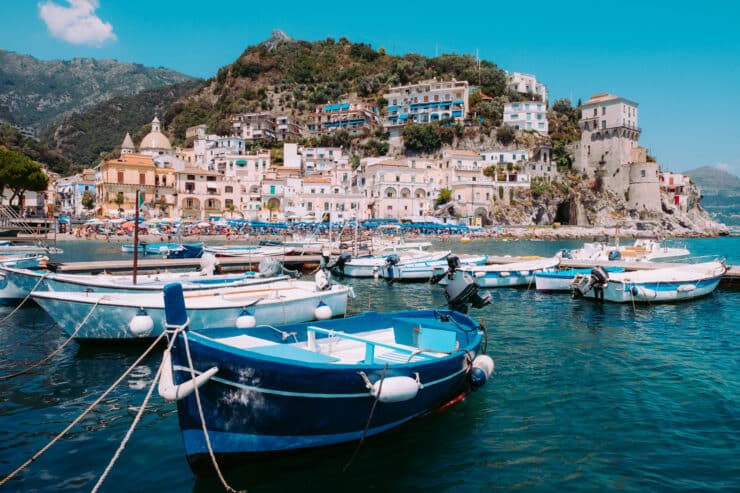
Cetara: The Working Fishing Village
Seafood lovers flock to Cetara as it’s rumored to have the best seafood on the Amalfi Coast. That likely springs from the fact that Cetara is a working fishing village and home to one of the most essential tuna fleets in the Mediterranean. The town is best known for colatura di alici, a fermented anchovy extract that locals consider “liquid gold.”
Beside Cetara is Erchie, a tiny hamlet with a massive Norman tower on the coast and two small beaches. Legend has it that Hercules founded the town on his arrival from Greece.
Best For: A no-frills experience, a less touristy experience, a good value
Vietri Sul Mare: The Pearl Of The Amalfi Coast
When coming from Salerno, Vietri sul Mare is the gateway to the Amalfi Coast. As the birthplace of the glazed pottery known as majolica, it’s also the ceramics capital of the Campania region, making it a great day trip destination for avid shoppers. Vietri’s pottery production dates back to Roman times, and back in the day, the royal court of Naples was its most important client.
Best For: Avoiding tourists; ceramics lovers; avoiding posh experiences; a simple seaside holiday
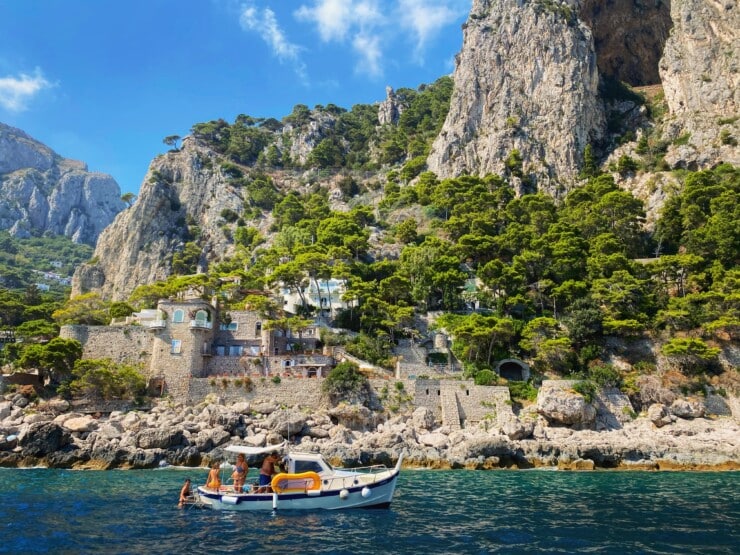
What To Do On The Amalfi Coast
As food lovers, we focus on the region’s food when we travel there. They have incredible seafood from tuna to anchovies and memorable dishes like eggplant meatballs, mozzarella in lemon leaf, pizza, scialatielli pasta, Spaghetti alla Nerano, and torta caprese. And, of course, you’ll come across local staples like limoncello and lovely white wines with bracing acidity.
However, it’s also one of Italy’s premier regions for hiking, boasting well-marked trails, including the famed Sentiero degli Dei (God’s Path), where our clients enjoy hiking with a local expert while visiting local farms to eat and cook with the locals.
The main activities our travel planning clients like are a day trip to see the island of Capri and its famed blue grotto, a day trip up to the town of Ravello, spending the day at one of the seaside beach clubs, shopping for local specialties like handmade sandals, ceramics, or going to a family-owned lemon grove that grows the local variety of lemons and doing a rustic dinner there, and, of course, doing a day trip to Pompeii and Vesuvius.
Frequently Asked Questions About Amalfi Coast Towns
Wondering, "Why is the Amalfi Coast so popular?" Well, there are many reasons. It has a rich history, having been inhabited since the Middle Ages, and has such iconic natural Mediterranean beauty that it's a UNESCO World Heritage Site. Also, the Amalfi Coast towns have long been a vacation spot for jet setters (see Talented Mr. Ripley).
Social media has blown it up and influencers now visit, marry, or honeymoon in Amalfi Coast towns. While we've traveled there countless times because it is stunning, there is a lot of hype about the Amalfi Coast on Instagram. So, let's get real: during the height of summer, the towns are packed with overnight guests and visitors from Naples and cruise ships.
The Amalfi Coast towns of Positano, Amalfi, and Ravello are the playground of A-listers who stay at luxury hotels or on private yachts. For most of our clients who travel to Italy, these towns are the most expensive leg. But it is an area worth visiting at least once. Or, returning for a deeper cut, where you stay on an island, at a quieter village (like Nerano, Praiano, or Minori), or inland at an agriturismo.
The Amalfi Coast is primarily a seaside beach destination, and the season generally runs from Easter until mid Septeember. However, as the fall has stayed warmer and as the Amalfi Coast has become even more popular, the season has extended through September.
The best time to travel to the Amalfi Coast is outside of the height of summer when crowds are highest. Since many of the hotels in the towns are pretty shut in the winter, it's best to travel there between April to October. We pick when to travel to the Amalfi Coast is late May, early June, and early September.
While you can do a day trip to the Amalfi Coast from Naples, Sorrento, or the islands, staying a few nights is best. Since reaching most of these towns (more below) takes a minute, we recommend spending at least three nights at these various Amalfi Coast towns.
Yes, you can get to the Amalfi Coast without a car! Most travelers take a flight or train into Naples and then have a private driver, take a ferry, or hop the local trains known as the Circumvesuviana and run from Naples to Sorrento. Otherwise, it's common to train into Naples or Salerno and take a bus, ferry, or car to the specific town you are trying to reach.
Year-round hydrofoils run between Naples and Sorrento and from Sorrento to Capri. Then, from April to October ferry service starts that runs from Sorrento to Positano, Amalfi, and onto Salerno. You can get public transport (bus or ferry) from those three spots, but you'll need a private car or boat service for the other towns.
As of 2022, new rules were proposed for driving the Amalfi Coast so be sure to read up on them should you want to drive there. For the record, we do not recommend driving in this region of Italy but rather taking one of the other transportation options mentioned above.
Get A Personalized Travel Itinerary
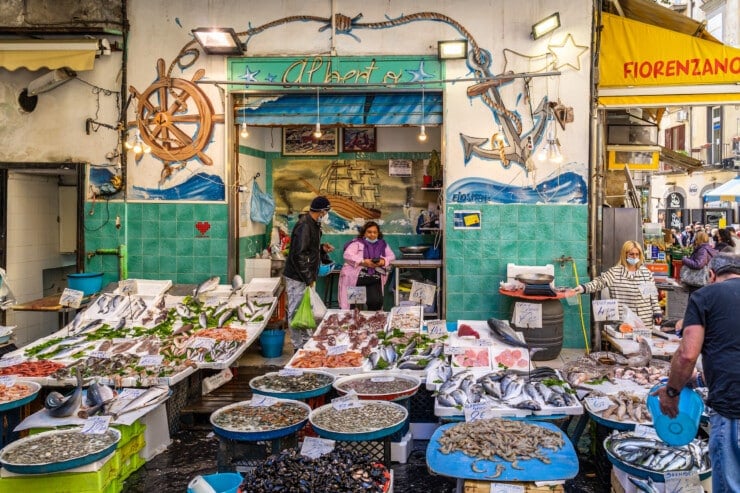
What To Eat In Naples
While on the Amalfi Coast, be sure to also at least do a day trip to Naples. As the home to pizza, incredible street food, and legendary desserts, there are many Naples Italy Foods to explore!

Classic Campanian Recipes
Want to cook up some flavors of Campania and the Amalfi Coast? Here are a few of our readers’ favorite classic Italian recipes:
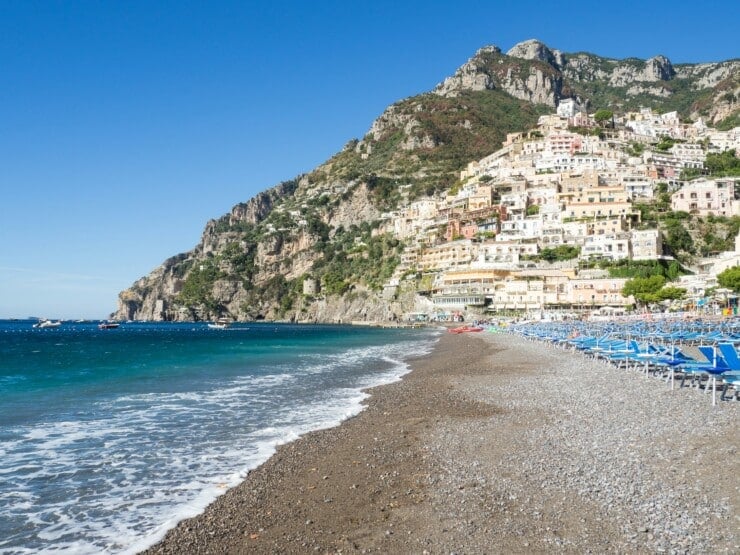
Campania Travel Guide
Are you considering traveling to Naples, the Amalfi Coast, and the Campania region in real life? Check out our free Campania Travel Guide for our best travel tips, recipes, and articles on Italy.
Have Us Plan Your Italy Trip
Did you know we’re also a boutique travel agency specializing in Italy travel planning? If you’re looking to plan one of the best trips to Italy, our Italy trip planner services are here to help you plan your perfect itinerary.
Photo Credit: Opening photo of Praiano by Alex Tihonovs; Sorrento by Alex Tihonovs; Amalfi town by Boris-B; Atrani town Photo by Patrick Schneider; Ravello by Sergey Berestestky; Maiori photo by Pfeiffer; Cetara by Eugenia Struk; Capri rocks Photo by Nicolò Salinetti